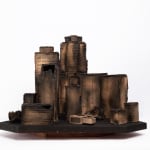Rodrigo Torres
sem título [untitled], 2021
cerâmica sobre base de madeira carbonizada
[ceramic on charred wood base]
[ceramic on charred wood base]
39 x 43 x 51 cm
[15 1/4 x 17 x 20 1/4 in]
10.1 kg
[15 1/4 x 17 x 20 1/4 in]
10.1 kg
Copyright O Artista
Mais imagens
-
(View a larger image of thumbnail 1
)

-
(View a larger image of thumbnail 2
)

-
(View a larger image of thumbnail 3
)

-
(View a larger image of thumbnail 4
)

-
(View a larger image of thumbnail 5
)

-
(View a larger image of thumbnail 6
)

-
(View a larger image of thumbnail 7
)

-
(View a larger image of thumbnail 8
)

-
(View a larger image of thumbnail 9
)

O projeto Colapso surgiu a partir da inquietação sobre quando deve ocorrer o colapso climático, quando atingiremos o ponto sem volta do aquecimento global e como serão nossas vidas quando...
O projeto Colapso surgiu a partir da inquietação sobre quando deve ocorrer o colapso climático, quando atingiremos o ponto sem volta do aquecimento global e como serão nossas vidas quando isso acontecer.
O trabalho se apresenta como uma maquete, um projeto para o futuro, que incorpora o objeto de sua destruição. Uma narrativa distópica, um tanto infantil, afinal pensar o futuro também é pensar nas crianças.
[The "projeto colapso" grew out of concerns about when climate collapse should occur, when we will reach the point of no return of global warming, and what our lives will be like when it does.
The work is presented as a model, a project for the future, which incorporates the object of its destruction. A dystopian narrative, somewhat childish, after all, thinking about the future is also thinking about children.]
O trabalho se apresenta como uma maquete, um projeto para o futuro, que incorpora o objeto de sua destruição. Uma narrativa distópica, um tanto infantil, afinal pensar o futuro também é pensar nas crianças.
[The "projeto colapso" grew out of concerns about when climate collapse should occur, when we will reach the point of no return of global warming, and what our lives will be like when it does.
The work is presented as a model, a project for the future, which incorporates the object of its destruction. A dystopian narrative, somewhat childish, after all, thinking about the future is also thinking about children.]
![Rodrigo Torres, sem título [untitled], 2021](https://artlogic-res.cloudinary.com/w_1800,h_1320,c_limit,f_auto,fl_lossy,q_auto/artlogicstorage/agentilcarioca/images/view/8bf3152a4bff2bf80389d696aecf48c8j/agentilcarioca-rodrigo-torres-sem-t-tulo-untitled-2021.jpg)
![Rodrigo Torres, sem título [untitled], 2021](https://artlogic-res.cloudinary.com/w_1800,h_1320,c_limit,f_auto,fl_lossy,q_auto/artlogicstorage/agentilcarioca/images/view/22189abc91a250c4c3bf4e8bf0a6ba3cj/agentilcarioca-rodrigo-torres-sem-t-tulo-untitled-2021.jpg)
![Rodrigo Torres, sem título [untitled], 2021](https://artlogic-res.cloudinary.com/w_1800,h_1320,c_limit,f_auto,fl_lossy,q_auto/artlogicstorage/agentilcarioca/images/view/f4236a033d129ffd4a37f6e7eab250a9j/agentilcarioca-rodrigo-torres-sem-t-tulo-untitled-2021.jpg)
![Rodrigo Torres, sem título [untitled], 2021](https://artlogic-res.cloudinary.com/w_1800,h_1320,c_limit,f_auto,fl_lossy,q_auto/artlogicstorage/agentilcarioca/images/view/687d4b7fc29c3a7655b418b4fb5c90faj/agentilcarioca-rodrigo-torres-sem-t-tulo-untitled-2021.jpg)
![Rodrigo Torres, sem título [untitled], 2021](https://artlogic-res.cloudinary.com/w_1800,h_1320,c_limit,f_auto,fl_lossy,q_auto/artlogicstorage/agentilcarioca/images/view/52d8004500a0277f258624f9e71f0c73j/agentilcarioca-rodrigo-torres-sem-t-tulo-untitled-2021.jpg)
![Rodrigo Torres, sem título [untitled], 2021](https://artlogic-res.cloudinary.com/w_1800,h_1320,c_limit,f_auto,fl_lossy,q_auto/artlogicstorage/agentilcarioca/images/view/70f22e2b559abcaa4ca4b9a64e501503j/agentilcarioca-rodrigo-torres-sem-t-tulo-untitled-2021.jpg)
![Rodrigo Torres, sem título [untitled], 2021](https://artlogic-res.cloudinary.com/w_1800,h_1320,c_limit,f_auto,fl_lossy,q_auto/artlogicstorage/agentilcarioca/images/view/4ad420c2507be5e10bc1c128643f80e6j/agentilcarioca-rodrigo-torres-sem-t-tulo-untitled-2021.jpg)
![Rodrigo Torres, sem título [untitled], 2021](https://artlogic-res.cloudinary.com/w_1800,h_1320,c_limit,f_auto,fl_lossy,q_auto/artlogicstorage/agentilcarioca/images/view/ed214741215e081398c47fa29b16dce9j/agentilcarioca-rodrigo-torres-sem-t-tulo-untitled-2021.jpg)
![Rodrigo Torres, sem título [untitled], 2021](https://artlogic-res.cloudinary.com/w_1800,h_1320,c_limit,f_auto,fl_lossy,q_auto/artlogicstorage/agentilcarioca/images/view/649c52693ff56e7d91100e95058c5242j/agentilcarioca-rodrigo-torres-sem-t-tulo-untitled-2021.jpg)